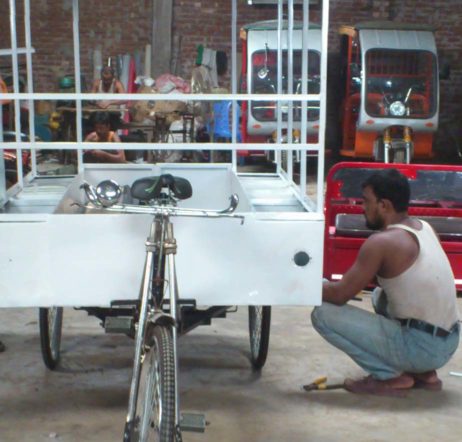- Group: CARG SIGHT
- Location: Bangladesh
- Chair: Akm Abdul Malek Azad


In spite of the enormous popularity gained due to their lesser traveling time and relatively cheaper fare, the battery operated rickshaws, pioneered by the Beevatech Ltd, have been banned from commercialization due to their energy consumption from our already overloaded national grid for charging their batteries. Housing a 48V brushless DC motor and a 48V 20Ah battery bank (factory default) these rickshaws can consume over 960Wh of energy from the national grid each time they are charged, the accumulation of which for the total number of rickshaws currently running countrywide is highly significant. In the current design of these rickshaws, the power supply to the load is controlled by a throttle system like motorcycles which has led to complete elimination of the human effort for running the rickshaw as opposed to reducing the human effort which was the original target. This in turn has led to higher energy consumption from the battery bank and consequently from the national grid as the battery energy is depleted more frequently.
In response to this predicament, CARC has conducted a research on making these rickshaws completely independent of the national grid through the use of solar energy and a newly developed technology and the birth of the pilot project “Power Conservation for Electrically Assisted Rickshaw-Vans with PV Support, Torque Sensor Pedal and Solar Battery Charging Station” took place. The research was conducted in a threefold approach:
A prototype rickshaw with these technologies has already been designed where each of these technologies has been implemented individually and tested for performance. It has been seen that the torque sensor pedal system and the PV array support system can save individually approximate 50% energy consumption by the rickshaw and the solar battery charging station can fully charge 50% discharged batteries within one day.
Encouraged by the results, CARC is now designing battery operated rickshaw vans which will be used for several different purposes – human hauler, cargo hauler and ambulance.
CARC has conducted a research about ways to make rickshaws independent of the national grid through the use of solar energy in three main areas:
A prototype rickshaw with these technologies has already been designed where each of these technologies has been implemented individually and tested for performance. It has been seen that the torque sensor pedal system and the PV array support system can save individually approximate 50% energy consumption by the rickshaw and the solar battery charging station can fully charge 50% discharged batteries within one day.
Encouraged by the results, CARC is now designing battery operated rickshaw vans which will be used for several different purposes – human hauler, cargo hauler and ambulance. Funding from IDCOL for the project has been a key to the success of the research, prototype, design and development of this project.
We initially started with IEEE funding to implement the solar power rickshaws and then slowly meet the unexpected challenge (i.e., human haulers, solar ambulances and cargo haulers) in Bangladesh.
It is always unwise to expect that things will go perfectly as planned. To mention some, the first problem was with the imports of some of the essential parts needed for the project. We have to depend on international companies to get torque sensor pedals and charge controllers. This resulted in an increase in the cost, delays and occasional miscommunication the required specifications. We realized if the purchases were done locally, this would not have been a problem.
Another problem is related to the infrastructure development of the country. The vans we have designed sometimes cannot be driven easily on extremely congested or muddy damaged roads. Since the target groups of people to be benefited by this project reside in the rural areas, we may have to consider an improved design for commercialization.
Also getting road permission is necessary. While conducting field tests some of the roads have not been accessible due to government policy.
From the very beginning of our project we have researched and worked on the sustainability. The manual rickshaw pullers have a net daily income of BDT500 – BDT 800. The pullers of the battery operated rickshaws typically have a net daily income of BDT 1000 to BDT 1200. The electrical assistance not only helps these people to earn more due to the lesser travelling time and thus more frequent trips, but also improves their health conditions due to reduced physical stress. With the PV array and the torque sensor pedal support their expense for charging and replacement of the battery is reduced significantly. A similar increase in income with the battery operated rickshaw vans is expected.
With electrical support added to the vans it will be possible to deliver goods to customers sooner, transport patients to and from hospitals in a safer and quicker manner and haul a large number of people with one place to another in an energy efficient and easy manner. Thus the earnings of the rickshaw van pullers are naturally expected to be much more than the normal rickshaw pullers. Despite the initial cost of the PV panels and torque sensor pedal installed modified vans, it will not take more than 12 months for the payback money upon their income. Initial cost is also the only investment to be done since there will be no additional electric charge and more battery durability because of the technology used in our design. Thus, this complete off-grid solution has the potential of great sustainability in the perspective of Bangladesh.